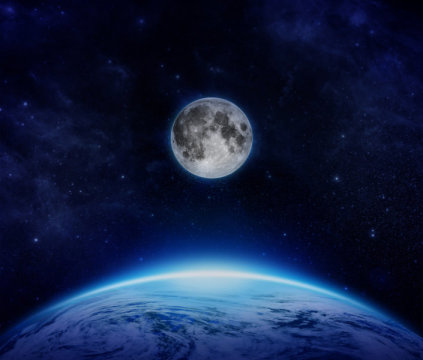Collision may have formed the Moon in mere hours, simulations reveal
Billions of years ago, a version of our Earth that looks very different than the one we live on today was hit by an object about the size of Mars, called Theia — and out of that collision the Moon was formed. How exactly that formation occurred is a scientific puzzle researchers have studied for decades, without a conclusive answer.
数十亿年前,一个看起来与我们今天生活的地球非常不同的地球被一个火星大小的物体撞击,这个物体叫做忒伊亚,在那次碰撞中形成了月球。它究竟是如何形成的,这是一个科学难题,研究人员研究了几十年,没有一个结定论的答案。
Most theories claim the Moon formed out of the debris of this collision, coalescing in orbit over months or years. A new simulation puts forth a different theory — the Moon may have formed immediately, in a matter of hours, when material from the Earth and Theia was launched directly into orbit after the impact.
大多数理论认为,月球是由这次碰撞的碎片形成的,在轨道上经过数月或数年的聚合。一项新的模拟提出了一种不同的理论——撞击后,当来自地球和忒伊亚的物质被直接发射到轨道上时,月球可能在几小时内立即形成。
“This opens up a whole new range of possible starting places for the Moon’s evolution,” said Jacob Kegerreis, a postdoctoral researcher at NASA’s Ames Research Center in California’s Silicon Valley, and lead author of the paper on these results published in The Astrophysical Journal Letters. “We went into this project not knowing exactly what the outcomes of these high-resolution simulations would be. So, on top of the big eye-opener that standard resolutions can give you misleading answers, it was extra exciting that the new results could include a tantalisingly Moon-like satellite in orbit.”
“这为月球的进化开辟了一个全新的可能起点,”位于加州硅谷的NASA艾姆斯研究中心的博士后研究员雅各布·凯格瑞斯(Jacob Kegerreis)说,他是发表在《天体物理学杂志快报》上的论文的主要作者。“进入这个项目时,我们并不知道这些高分辨率模拟的结果会是什么。因此,除了让人大开眼界的是,标准分辨率可能会给你误导的答案之外,更令人兴奋的是,新结果可能包括一颗在轨道上运行的类似月球的诱人卫星。”
The simulations used in this research are some of the most detailed of their kind, operating at the highest resolution of any simulation run to study the Moon’s origins or other giant impacts. This extra computational power showed that lower-resolution simulations can miss out on important aspects of these kinds of collisions, allowing researchers to see new behaviors emerge in a way previous studies just couldn’t see.
在这项研究中使用的模拟是同类中最详细的,在研究月球起源或其他巨大撞击的模拟中,以最高的分辨率运行。这种额外的计算能力表明,低分辨率的模拟可能会错过这类碰撞的重要方面,使研究人员能够以以前的研究无法看到的方式看到新的行为的出现。
A Puzzle of Planetary History
行星历史之谜
Understanding the Moon’s origins requires using what we know about the Moon — our knowledge of its mass, orbit, and the precise analysis of lunar rock samples — and coming up with scenarios that could lead to what we see today.
了解月球的起源需要利用我们对月球的了解——我们对它的质量、轨道和对月球岩石样本的精确分析——并提出可能导致我们今天所看到的情景。
Previously prevailing theories could explain some aspects of the Moon’s properties quite well, such as its mass and orbit, but with some major caveats. One outstanding mystery has been why the composition of the Moon is so similar to Earth’s. Scientists can study the composition of a material based on its isotopic signature, a chemical clue to how and where an object was created. The lunar samples scientists have been able to study in labs show very similar isotopic signatures to rocks from Earth, unlike rocks from Mars or elsewhere in the solar system. This makes it likely that much of the material that makes up the Moon originally came from Earth.
以前流行的理论可以很好地解释月球属性的某些方面,比如它的质量和轨道,但有一些主要的警告。一个悬而未决的谜团是月球的成分为何与地球如此相似。科学家可以根据一种物质的同位素特征来研究它的组成,这是一种关于物体如何以及在哪里被创造出来的化学线索。科学家们能够在实验室中研究的月球样本显示出与地球岩石非常相似的同位素特征,而不像来自火星或太阳系其他地方的岩石。这使得构成月球的大部分物质很可能最初来自地球。
In previous scenarios where Theia sprayed out into orbit and mixed with only a little material from Earth, it’s less likely we’d see such strong similarities — unless Theia was also isotopically similar to Earth, an unlikely coincidence. In this theory, more Earth material is used to create the Moon, particularly its outer layers, which could help to explain this similarity in composition.
在之前的场景中,忒伊亚喷射到轨道上,只与来自地球的少量物质混合,我们不太可能看到如此强烈的相似性——除非忒伊亚也与地球的同位素相似,这是不太可能的巧合。在这个理论中,更多的地球物质被用来创造月球,特别是它的外层,这有助于解释这种成分上的相似性。
There have been other theories proposed to explain these similarities in composition, such as the synestia model — where the Moon is formed inside a swirl of vaporized rock from the collision — but these arguably struggle to explain the Moon’s current orbit.
也有人提出了其他理论来解释这些成分上的相似性,比如索内斯蒂亚模型——月球是在碰撞后的汽化岩石漩涡中形成的——但这些理论都难以解释月球目前的轨道。
This faster, single-stage formation theory offers a cleaner and more elegant explanation for both these outstanding issues. It could also give new ways to find answers for other unsolved mysteries. This scenario can put the Moon into a wide orbit with an interior that isn’t fully molten, potentially explaining properties like the Moon’s tilted orbit and thin crust — making it one of the most enticing explanations for the Moon’s origins yet.
这种更快的单阶段形成理论为这两个突出问题提供了更清晰、更优雅的解释。它也可以为寻找其他未解之谜提供新的方法。这种情况可以使月球进入一个较宽的轨道,内部不是完全熔融的,这可能解释了月球的倾斜轨道和薄地壳等特性——这是迄今为止对月球起源最诱人的解释之一。
Getting closer to confirming which of these theories is correct will require analysis of future lunar samples brought back to Earth for study from NASA’s future Artemis missions. As scientists gain access to samples from other parts of the Moon and from deeper beneath the Moon’s surface, they will be able to compare how real-world data matches up to these simulated scenarios, and what they indicate about how the Moon has evolved over its billions of years of history.
要进一步确认这些理论中的哪一个是正确的,需要对NASA未来的阿耳特弥斯任务带回的月球样本进行分析。随着科学家们获得来自月球其他地方和月球表面以下更深处的样本,他们将能够比较真实世界的数据如何与这些模拟场景相匹配,以及这些数据表明月球在数十亿年的历史中是如何演变的。
A Shared Origin
共同的起源
Beyond simply learning more about the Moon, these studies can bring us closer to understanding how our own Earth became the life-harboring world it is today.
除了简单地了解月球之外,这些研究还能让我们更深入地了解我们的地球是如何变成今天这个孕育生命的世界的。
“The more we learn about how the Moon came to be, the more we discover about the evolution of our own Earth,” said Vincent Eke, a researcher at Durham University and a co-author on the paper. “Their histories are intertwined — and could be echoed in the stories of other planets changed by similar or very different collisions.”
“我们对月球是如何形成的了解越多,我们就越能发现地球的进化,”杜伦大学(Durham University)的研究员、论文的合著者文森特·埃克(Vincent Eke)说。“它们的历史是交织在一起的,可能会在其他行星因类似或非常不同的碰撞而改变的故事中得到呼应。”
Read more at ScienceDaily.com
在ScienceDaily.com阅读更多











